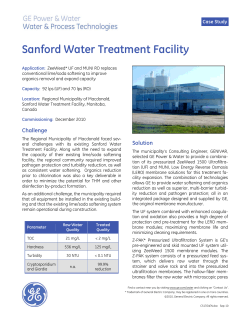
M. Diouri , L. El Amraoui R. Jaenicke , L. Schütz
1 M. Diouri , L. El Amraoui R. Jaenicke2, L. Schütz2 1 1 Laboratoire de Physique de l’Atmosphère, Université Oujda, Morocco 2 Institut für Physik der Atmosphäre, Universität Mainz, Germany Atmospheric turbidity over the Angad area of Morocco Introduction The Linke turbidity factor, which is defined as the ratio of the integral optical depth of the total extinction divided by the optical depth due to Rayleigh scattering only, is a convenient measure for the total load of atmospheric trace compounds in the vertical column (Louche et al. 1986). This analysis is performed from records of global and diffuse radiation measured by a set of two pyranometers under clear sky conditions. The diffuse radiation pyranometer is conducted by using an instrument equipped with a shadow band. The two pyranometers (Kipp & Zonen, Type CM 11; Fig. 1) are installed at the Oujda university campus as a part of an automatical meteorological station located south-east of Oujda city (34°40'N, 1°50'W 580 m of altitude). We can consider that the Results urban aerosol has very low influence according to the wind direction frequency and the distance to the city center. Oujda itself is located at the northern foothills of the Atlas mountains (about 60 km south of the Mediterranean sea). It is often affected by a land-sea circulation, except for cases when major pressure systems or storms are passing. Thus, daily intrusions of maritime air masses are replacing the dry continental air masses, which are advected from the south during night time in the boundary layer from the late night to the morning. In this region called Angad region (north-east of Morocco), the precipitation is rare and the sky is often clear. Therefore the atmospheric turbidity reflects above all the atmospheric aerosol load. The Linke turbidity factor was calculated via the direct solar radiation determined from actual measurements of diffuse and global solar radiation after a Linke data evaluation scheme (Louche et al. 1986 and Schütz et al. 1993). A three years time series of Linke turbidity factors (Fig. 2) presents values ranging from 1.5 to 12 and shows a summer maximum. The frequency distribution (Fig. 3) shows a maximum for values of about 2.7. Compared to other locations, the Angad average atmospheric turbidity has relative low values which are found more commonly at mountain stations than at Mediterranean or European cities. This result may be explained by the large number of 230 clear days per year, of which only days during a four month cyclic period show high turbidity values. This four month period starting in May is characterized by exceptional advection of Saharan air masses coming from the southeast of Morocco. During this time high turbidity values larger than 6 can be observed, and also high mass concentrations are found (Meziani et al., 2000). Conclusions The large variations during summer are obviously caused by single local and Saharan dust impacts. The general pattern has some similarity to spectral measurements (El Amraoui et al., 2000), where only wavelengths with strong aerosol extinction have been investigated. The range of values for Linke turbidity factor is representative for continental areas with low pollution (Helmes and Jaenicke, 1988). The Linke turbidity factor and its determination is a rather low-priced and simple tool compared to spectral measurements to monitor long-term variations of total columnar loading of atmospheric trace compounds. 25 relative frequency, % 20 15 10 5 0 Fig. 1: Pyranometers at the Oujda university campus meteorological station 1 2 3 4 5 6 7 8 9 Linke turbidity factor 10 11 12 13 Fig. 3: Frequency distribution of Linke turbidity factor for Oujda 1996 to 1998 Acknowledgement 10 This work was supported by the German Science Foundation (DFG) and the Deutsche Gesellschaft für Technische Zusammenarbeit (GTZ) under the project number JA 344/9-1 and PN93.2157.106.100. El Amraoui, L., M. Diouri, M. El Hitmy, R. Jaenicke, L. Schütz, and W. von Hoyningen-Huene (2000): Aerosol optical parameters over North Eastern Morocco. J. Aerosol Sci. 31, Suppl. 1. Helmes, L. and R. Jaenicke (1988): Long-term series of atmospheric turbidity estimated from records of sunshine duration and cloud cover. In: Aerosols and Climate. P. V. Hobbs and M. P. McCormick, Eds. Deepak Publ., 139-146. Louche, A., G. Peri, and M. Iqbal (1986): An analysis of Linke turbidity factor. Solar Energy 37, No. 6, 393-396. Meziani, N., A. Azzaoui, M. Diouri, and L. El Amraoui (2000): Particle mass distribution of the fine fraction of soil born dust from eastern Morocco. J. Aerosol Sci 31, Suppl. 1. Schütz, L., M. Flender, and L. Helmes (1993): Atmospheric turbidity over the Rhein-Main area, FRG. Annales Geophysicae, Part II, Vol. 11, Suppl. II, C 273. 8 Linke turbidity factor References 9 7 6 5 4 3 2 1 J F MA MJ J A S ON D J F MA MJ J A S ON D J F MA MJ J A S ON D 1996 1997 1998 Fig. 2: Time series of Linke turbidity factor for Oujda 1996 to 1998 Design 2000 by K. Kandler
© Copyright 2025











